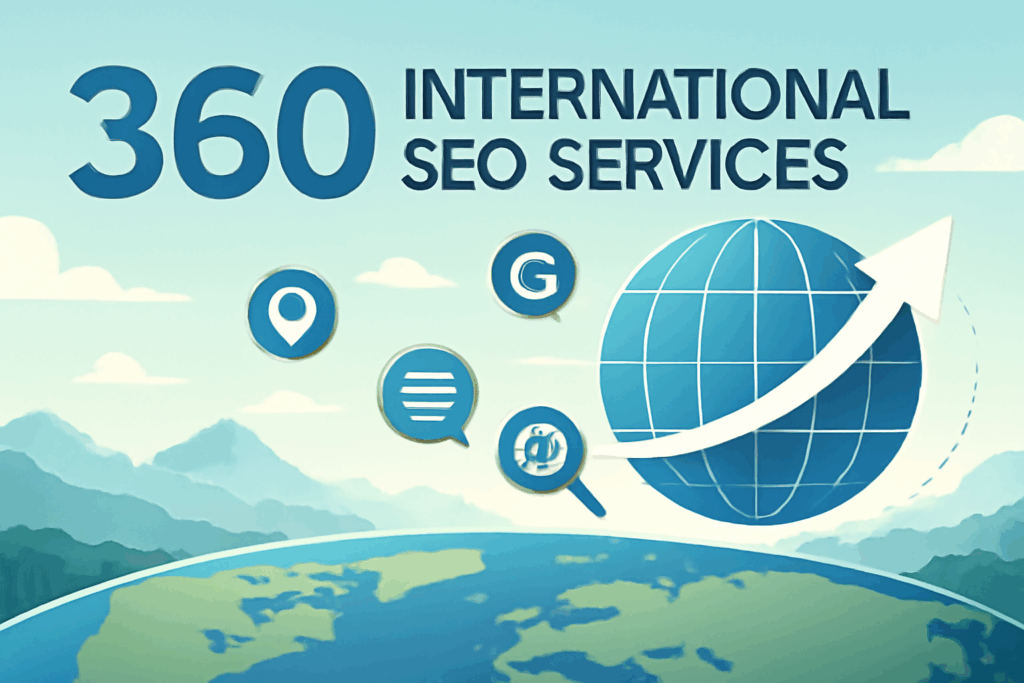In today’s interconnected world, having a strong presence in your home market is just the start. To truly scale, your brand must show up when people search in other countries, in their languages, and within their cultural context. That’s where 360 international SEO services come into play. A full-spectrum strategy ensures you don’t just translate your content, but you adapt, optimize, and localize your site so that it ranks and resonates globally.
Table of Contents
ToggleIn this article, we will break down what “360 International SEO” means, why it matters, and how DigitalMarketing360 can help clients succeed across borders.
What Are 360 International SEO Services?
“360 SEO” generally means a holistic, all-around SEO strategy that covers technical, content, on-page, off-page, local, and user experience aspects. When we prefix “international,” it means applying that full strategy across multiple countries, languages, and regional markets.
So 360 International SEO isn’t just about adding multiple languages, it’s about:
- Technical setup (site architecture, hreflang, canonicalization)
- International keyword research & mapping
- Multilingual content & localization
- Geo-targeting and domain strategy
- Link building and outreach in target markets
- Ongoing monitoring, analytics, and iteration
Why 360 International SEO Matters (and Its Benefits)
Expanding globally involves more than simply translating. Here are key reasons to adopt a 360 international SEO approach:
- Reach new audiences & markets
With proper SEO in local languages and markets, your brand can attract traffic from countries you have never tapped before. - Better user experience & trust
Localizing content (not just translating) shows respect for cultural context, idioms, and preferences, increasing engagement and conversions. - Compete locally in each region
Global brands that optimize regionally outrank those that remain generic. With 360 approach, you adapt to local competition and ranking signals. - Technical correctness avoids SEO pitfalls
Mistakes like duplicate content, wrong hreflang tags, poor site architecture, or URL confusion can hurt your rankings globally. A full strategy prevents these. - Sustainable growth & brand strength
Once each market is set up well, you get compounding traffic, links, and authority in each region, strengthening your overall domain.
Key Components of 360 International SEO
Let’s dive into the pieces that must be handled correctly for a robust international SEO framework:
1. Target Market & Keyword Research for Each Region
- You cannot assume the same keywords translate directly. Search behavior, idioms, and volume differ per language and country.
- Use tools and local datasets to find region-specific keywords.
- Map keywords to landing pages per locale.
2. Domain & URL Strategy
You must choose how to structure your international site:
- ccTLDs (e.g., example.fr, example.de) — strong local signals but cost/management overhead
- Subdirectories (example.com/fr/) — simpler, good domain authority benefit
- Subdomains (fr.example.com) — more flexible but weaker domain signal sometimes
- Use canonical tags and hreflang to avoid duplication and signal language/market.
3. Hreflang & Technical Setup
- Hreflang tags tell search engines which language/region version to serve.
- Correct canonicalization to avoid duplicates.
- Use language meta tags, avoid conflicting signals.
- Ensure server locations, CDNs, speed optimization, and mobile readiness local users expect fast sites.
4. Localized Content & Translation
- Don’t just “translate” localize (idioms, tone, cultural references).
- Use native language writers/editors.
- Adapt images, units, date formats, examples, currency, etc.
- Content should be unique per region where relevant, avoiding duplicate content issues.
5. Regional Link Building & Outreach
- Build backlinks from local sites, blogs, and media in each region.
- Guest posts, collaborations, and local PR.
- Local citation and directory listings (if applicable in that country).
6. Analytics, Monitoring & Iteration
- Use Google Search Console, Bing Webmaster, and regionally relevant search consoles.
- Track rankings, traffic per locale, bounce rates, conversions.
- A/B test content, UX per market.
- Iterate regionally, not globally; one size fits all.
7. Governance & Scale
- Content workflows, translation process, and version control.
- Ensuring consistency in brand voice while allowing local flexibility.
- Budget and resource allocation per market.
Challenges & How to Overcome Them
Even strong 360 strategies run into obstacles. Being aware helps you plan correctly.
| Challenge | What Can Go Wrong | Mitigation / Solution |
|---|---|---|
| Duplicate content | If multiple versions of pages appear, search engines won’t know which is canonical | Use correct canonical + hreflang tags; ensure localized uniqueness |
| Wrong language signals | You won’t gain regional authority | Consistent tags, server signals, sitemaps |
| Search engines may serve the wrong locale | A site hosted far away will load slowly for local users | Allocate budget/efforts to outreach in each region |
| Poor translation or awkward phrasing | Users lose trust | Use native language experts |
| Lack of local backlinks | Use CDNs, local servers, and caching | Use CMS tools, modular content, and process governance |
| Complex maintenance & versioning | Managing many localized versions can be heavy | Use CMS tools, modular content, process governance |
How DigitalMarketing360 Implements 360 International SEO (Your Value Proposition)
Here’s how you can position your service offering in an informative way:
- Market Selection & Prioritization
We help clients choose which countries, languages, and regions to target — based on data, competition, and business goals. - Localization Strategy & Content Production
Native writers + SEO experts create content that’s culturally adapted, not just a literal translation. - Technical Setup & SEO Foundation
We build the multilingual architecture (ccTLD / subdirectory/subdomain) + set up hreflang, canonical tags, and technical optimizations per locale. - Local Link Building & Outreach
We run regionally targeted link campaigns, PR, and content partnerships with local publications to boost authority. - SEO Monitoring & Analytics per Locale
We track performance per region, identify underperforming markets, and optimize iteratively. - Ongoing Maintenance & Scaling
As you expand into more markets, we provide governance, workflow, translations, and scale up without breaking SEO.
Tips to Get Started – A Mini Roadmap
- Audit your current site — find existing multilingual content, duplicate issues, and missing tags.
- Select 1 or 2 pilot markets — don’t start with 20 languages; choose markets you can commit resources to.
- Do regional keyword research — find demand + competition in that locale.
- Plan site structure & technical setup — choose domain strategy and implement tags.
- Produce localized content — for landing pages, blog posts, metadata.
- Begin outreach & link building in those regions.
- Monitor & optimize — see what works, replicate in other markets gradually.
Conclusion & Call to Action
Expanding globally is no longer optional for many brands—it’s essential. But to do it well, you need more than translation; you need a 360 international SEO strategy that covers technical, content, local, and authority-building facets for each target region.






